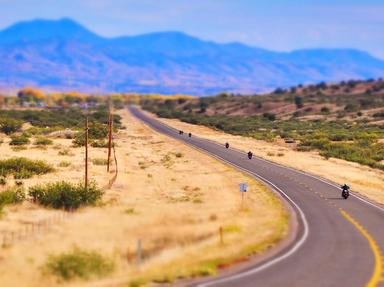Quiz Answer Key and Fun Facts
1. About 1.6 million years ago, the Jemez Mountains as we now know them were formed in a cataclysmic volcanic eruption that released some 50 cubic miles of ash. Is the region still geologically active?
2. Many, many years passed. Flowing water easily carved caves and canyons in the soft volcanic rock that coated the surrounding mesas. What is the name for this type of rock, made up of compacted ash?
3. In the eastern part of the Jemez Mountains, one of the mightiest Western rivers flows through a deep rift valley. What is the U.S. name of this river, which begins in Colorado and forms the border between Texas and Mexico?
4. From the eastern foothills of the Jemez Mountains, the traveler is treated to a spectacular view over much of north-central New Mexico. Looking east, you can see mountains towering over Santa Fe; they're a range of the Rockies. What name does this mountain range have, given in tribute to its glorious red color during some sunrises and sunsets?
5. The Jemez Mountains were once home to an ancient people whose cliff dwellings are found all over the Southwest. Although they were probably the ancestors of the modern Pueblo peoples, we don't know what this ancient group called themselves, so we commonly call them by what name given to them by ancient Navajos?
6. These ancient cliff-dwellers left behind a large number of pictures carved into the rock. In some cases, these pictures stand out dramatically: the artists pecked through the dark patina of volcanic rock to reveal the lighter stone underneath. What is this type of art called?
7. Some of the best-preserved, most accessible archaeological sites in New Mexico are found in a 33,000 acre national monument centered on Frijoles Canyon in the Jemez Mountains. Paved trails running along the cliffside take visitors through cliff dwellings and to a "ceremonial cavern" with a reconstructed kiva. What is the name of this monument, named for a 19th-century anthropologist?
8. In the southern Jemez Mountains lies the Jemez Pueblo, a sovereign indigenous nation with about 3,400 tribal members. This pueblo, whose roots in the region go back to the late 1200s, is one of how many federally recognized pueblos in the state of New Mexico?
9. Despite the beauty of the Jemez Mountains, this region is strongly associated with one of the most destructive moments of human history: the development of the atomic bomb. In 1943, Oppenheimer, Fermi, Teller, and other scientists of the Manhattan Project moved their operations here, in hopes that the remote location would improve security and secrecy. The laboratory they founded outlasted the war, and still conducts scientific research for the government to this day. What is the name of this lab?
10. In the year 2000, Congress purchased 89,000 acres of ranchland in the volcanic caldera in the center of the Jemez Mountains. This land now comprises the beautiful Valles Caldera National Preserve, where herds of elk roam and where visitors can hike, fish, cycle, or even ride horseback. But what happened to the cattle who grazed there in the summer?
Source: Author
CellarDoor
This quiz was reviewed by FunTrivia editor
LilahDeDah before going online.
Any errors found in FunTrivia content are routinely corrected through our feedback system.
